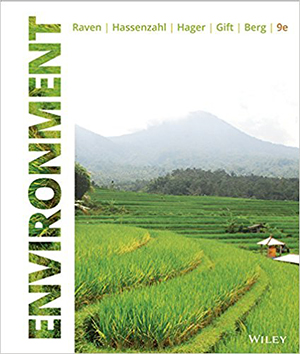
Environment, 9th Edition
By Peter H. Raven, David M. Hassenzahl, Mary Catherine Hager, Nancy Y. Gift, Linda R. Berg
Environment uses the central themes of Systems and Sustainability to help students understand the connection between the core concepts of Environmental Science and their daily lives. The course features a rich collection of current case studies and examples highlighting local and regional issues, which provide students with the science and tools to understand, apply, and think critically about environmental science. It also provides instructors with powerful tools to assess individual student progress well as the progress of the class as a whole.
Schedule a Demo Sign Up for a Test Drive Adopt WileyPLUSWant to learn more about WileyPLUS? Click Here
Read, Study, and Practice
Students learn course concepts using the complete online eTextbook, flashcards, crossword puzzles, practice questions, videos, and animations. Organized by learning objective, students can filter for relevant learning resources based on what they need to study most and print any section of the eTextbook
ORION Adaptive Practice (when available
Every student has a different starting point, and adaptive practice provides endless opportunities for practice to effectively prepare for class or quizzes and exams. Active retrieval of information with practice questions is proven to improve retention of information better than re-reading or reviewing the material, and students who use adaptive practice to prepare for exams do significantly better than those who do not. Students begin with a quick, chapter-level diagnostic to determine their initial level of understanding, and they can use the dashboard and quick reports to see what topics they know and don’t know.
Assignments
Students who fully engage in WileyPLUS assignments do better in the course by more than a letter grade. Auto-graded assignments give students immediate feedback based on flexible assignment settings determined by the instructor, while the notification center allows students to set their own email notification policies to stay on track.
Instructors can select from extensive and reliable question banks to create and deploy reading, practice, homework, pre-post lectures, and assessment assignments. This course includes essay, label drag-and-drop, multiple choice, text entry, and true-/false question types.
Assignments
Students who fully engage in WileyPLUS assignments do better in the course by more than a letter grade. Auto-graded assignments give students immediate feedback based on flexible assignment settings determined by the instructor, while the notification center allows students to set their own email notification policies to stay on track.
Gradebook
Students know where they stand on WileyPLUS assignments, and they can track progress by learning objective.
Instructors have insights into student performance at the granular question attempt and can track trends by individual student, assignment, or learning objective. Flexible policies allow instructors to change points, set assignment weighing policies, extend individual due dates, or drop the lowest grade.
Chapter 1. Introducing Environmental Science and Sustainability
Chapter 2. Environmental Laws Economic and Ethics
Chapter 3. Ecosystems and Energy
Chapter 4. Ecosystems and the Physical Environment
Chapter 5. Ecosystems and Living Organisms
Chapter 6. Major Ecosystems of the World
Chapter 7. Human Health and Environmental Toxicology
Chapter 8. The Human Population
Chapter 9. The Urban World
Chapter 10. Energy Consumption
Chapter 11. Fossil Fuels
Chapter 12. Renewable Energy and Nuclear Power
Chapter 13. Water: A Limited Resource
Chapter 14. Soil Resources
Chapter 15. Mineral Resources
Chapter 16. Biological Resources
Chapter 17. Land Resources
Chapter 18. Food Resources
Chapter 19. Air Pollution
Chapter 20. Global Climate Change
Chapter 21. Water Pollution
Chapter 22. Pest Management
Chapter 23. Solid and Hazardous Waste
Chapter 24. Tomorrow’s Word

